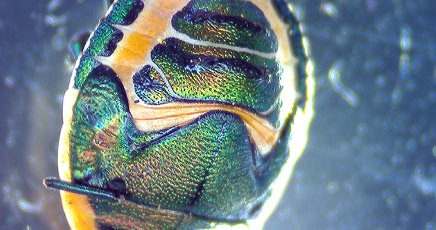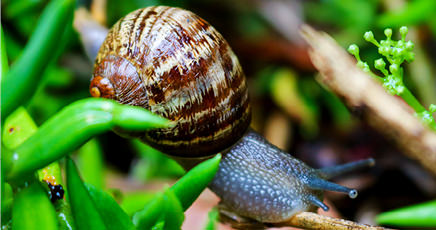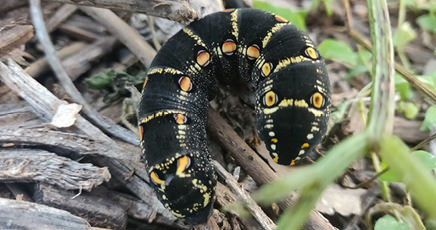STORY
Every time Suyin is outdoors, she is fascinated by the myriad of bugs she sees. She recently learnt from her grandfather that bugs are invertebrates. Invertebrates are all the living things that have no backbone. They are all around us, and come in all shapes and sizes. Spot the spider weaving its web: invertebrate. Spot the worm happily growing in the compost bin: invertebrate. Spot that fly buzzing in your ear! Also an invertebrate.
Over 90% of the planet’s animal species are invertebrates, meaning they are everywhere, just going about their business. Suyin’s grandfather also told her that while many humans see bugs to be irritating and bothersome, it is important to learn why they are significant to our ecosystem and how they help ensure we can all share a healthy planet.

Invertebrates perform many different roles in a garden’s ecosystem and occupy many different habitats. In this activity, you will be completing an assessment of these animals. The aim of this activity is for children to identify invertebrates, appreciate different invertebrate habitats and understand the roles that these animals play.
This learning activity is the first part of a sequence of 3 individual learning activities focused on creating a beneficial garden. The order of these activities are: assessment, investigation and planting.
For children to:
- look closely for invertebrates outdoors and identify those which are present
- understand the important role that invertebrates play in the environment
- make connections on how invertebrates use their habitats
- collect and display data from a field investigation
- use visual clues to classify invertebrates, such as how many legs an animal has.
Invertebrates are likely to be more visible in temperatures above 20⁰ C. Some invertebrates will go into diapause, similar to hibernation, to avoid extreme cold or heat. So the best time of day to look for invertebrates is between 10am and 2pm.
If you live in a temperate region, it is best to run this activity from September to April as more invertebrates will be active during the warmer months.
Introduction
We’re going on a bug-hunt! A ‘bug’ is the broad term given to an invertebrate animal (animals without a backbone). Many different invertebrates visit gardens, or call them home. In this activity, you will be completing an assessment of the types of invertebrate in the garden. They could range from worms that break down organic matter, to bees that pollinate flowers, or even pest animals that eat crops, such as snails and slugs. This activity is designed to provide the knowledge and tools for other learning activities in this sequence.
*Time allocation will be dependent on site selection and travel time.
Checklist
Instructions

Step 1
Why do invertebrates matter?
Discuss the term invertebrate and how it describes animals without a backbone.
Discuss the important roles that they play in the garden. Some invertebrates, such as worms are detritivores and they break down material and recycle nutrients.
Insects such as bees, and even flies, play an important role in pollination. As pollinators, bees carry pollen from flower to flower to help the flowering plants make seeds, reproduce and make new plants. Bees help to grow our food. Without pollinators such as bees, animals and humans would be without seeds, nuts and fruits to eat.
Other invertebrates, such as spiders, are important predators and help to keep the garden ecosystem in balance.
Discuss the invertebrates that the children know about and the roles they may play as decomposers, pollinators and as a food source for insectivores.
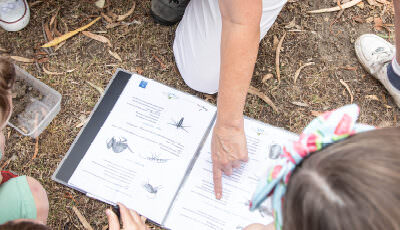
Step 2
Examine your chosen field guide with the children (device or printed version) prior to exploring outside. Point out an invertebrate that they are likely to observe, such as a bee, and model how to use the field guide. Discuss the role that the bee may play in the garden.
Outline safety aspects to the children, when observing invertebrates:
- be gentle and quiet observers; do not touch any of the invertebrates.
- instruct how to use the garden trowels, spoons, paddle sticks or paintbrushes.
- guide the children to tread lightly, taking care not to stand on anything living while exploring.
- ask the children to return things back to how they found them, e.g. turned rocks or logs.
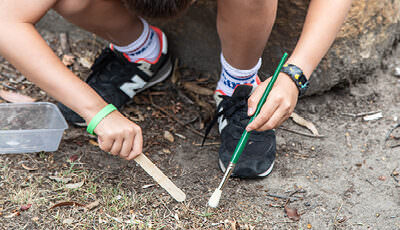
Step 3
Head outside to your observation site. Invertebrates are everywhere but finding a spot near a garden bed or away from asphalt will allow children the opportunity to do some light digging.
Allow children time for ‘slow looking’ in a micro environment. Encourage the children to explore the site, carefully looking at different locations using their senses to lead them.
Carefully look at flowers to see if there are any active bees or other flying insects. Use the trowels or spoons to gently turn over the topsoil, bark, small rocks and leaf litter looking for ground dwelling invertebrates such as snails, worms or millipedes. Using the paddle sticks or paintbrushes, attempt to move the insects into the plastic container for observation.
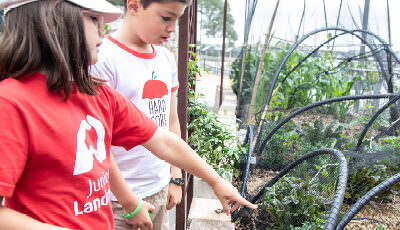
Step 4
If the children are successful at spotting an invertebrate, see if they can identify it using their field guide.
Show the children how to use visual cues, such as how many legs the invertebrate has, to help classify them.
You might like to take photos to capture your observations.
Model how to use the activity sheet to record the data and how the data can be displayed in a graph.
You will be able to refer back to the data from this assessment during the other activities in this activity sequence.
Use the activity sheet to encourage the children to make careful observations and thoughtful interpretations during and after the activity.
Extension Activity
Use Information Computer Technology (ICT) programs such as Excel to display your data in different types of graphs. Share it on your organisation’s communications platform.
Time your invertebrate activity to run during a local community celebration. It’s a great way to celebrate together and get people involved in finding and learning about invertebrates. Celebrate Landcare Week at the start of August!
Curriculum and Framework Links
SCIENCE
Year 2: ACSSU030, ACSHE035
Year 3: ACSSU044, ACSIS054
Year 4: ACSHE062, ACSIS064
Year 5: ACSHE083
Year 6: ACSSU094, ACSHE100
Year 7: ACSHE120
Year 8: ACSHE135
HUMANITIES AND SOCIAL SCIENCES
Year 2: ACHASSI042
Year 3: ACHASSI052, ACHASSI059, ACHASSI060
Year 4: ACHASSI080, ACHASSK088, ACHASSK090
Year 5: ACHASSI102, ACHASSK120
Year 6: ACHASSI122, ACHASSI130
DESIGN AND TECHNOLOGIES
Year 2: ACTDEK003
Year 3 & 4: ACTDEP017
Year 5 & 6: ACTDEP019
Year 7 & 8: ACTDEK032
HEALTH AND PHYSICAL EDUCATION
Year 2: ACPPS018, ACPPS022, ACPPS023
Year 3 & 4: ACPPS036, ACPPS040, ACPPS041
Year 5 & 6: ACPPS054, ACPPS059
Year 7 & 8: ACPPS073, ACPPS078
ETHICAL UNDERSTANDING
Exploring values, rights and responsibilities
PERSONAL AND SOCIAL CAPABILITY
Social awareness
CURRICULUM CONNECTIONS
Outdoor Learning
CROSS CURRICULUM PRIORITY
Sustainability
My Time, Our Place: Framework for School Age Care
Outcome 2 and 4
Reference List
ONLINE RESOURCES
Museum Victoria has developed a free National Field Guide app for Android and Apple devices. There are eight apps available so choose one best suited to your location (NSW, ACT, VIC, SA, NT, QLD, WA & TAS).
Download the Urban Wildlife app for free to help you identify beneficial insects in your area.
What are insects? and Bugwise fact sheets from the Australian Museum.
Explore bugs and insects from Backyard Buddies.
PRINTABLE RESOURCES
The Australian Museum has a free Bugwise Invertebrate Guide to help your children identify common spiders, insects and other invertebrates from illustrations.
Insect identification tips from the Wild Pollinator Count.
WATCH
Watch and learn about Australian native bees from ABC’s Gardening Australia.
Find out how farmers are working with entomologists in this Landline Video.
ACKNOWLEDGEMENT
This learning activity has been developed in partnership with the Victorian Government Department of Environment, Land, Water and Planning
IMAGE ATTRIBUTION
Feature image:
Hover flies on flowering bok choi courtesy of Sam Harrison
Other images:
Photo of beetle, caterpillar, spider and ant courtesy of Callum Fleming, Western Sydney University
Photo of aphids courtesy of Sam Harrison
Photo of bee on purple flower by Amity L. (2020 What’s in your backyard challenge Top 100)
We value your feedback
When you have finished this learning activity, please tell us what you think with our survey.
Your feedback will help Landcare Australia improve the activities in the Junior Landcare Learning Centre.
Why not try one of our other Junior Landcare learning activities?
Creating a butterfly garden
Biodiversity
Love Letters to the Land
Biodiversity|First Nations Perspectives|Food Production|Waste Management
Creating a sensory garden
Biodiversity
Understanding weeds: life cycle
Biodiversity
